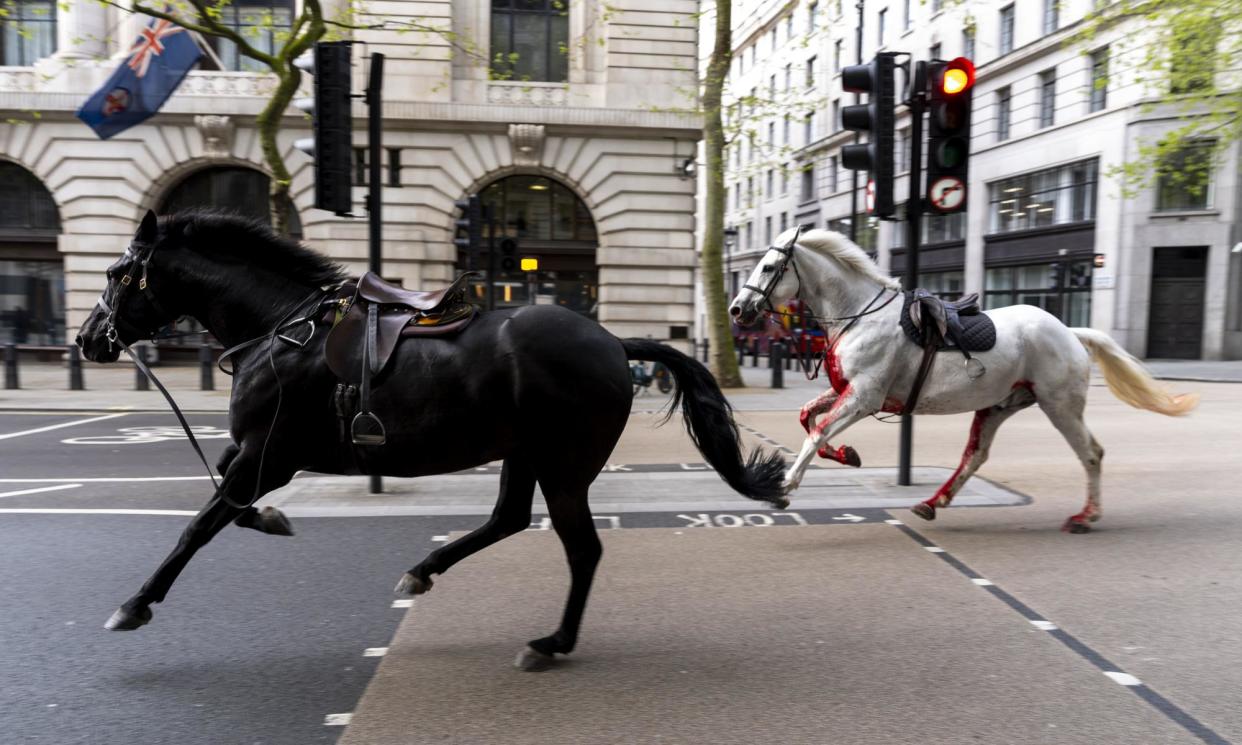Runaway horses set to steal show at trooping the colour on Saturday

The bearskins, marching bands and palace balcony appearances that ensure trooping the colour is an annual crowd-puller will face competition when this year’s military spectacle takes place on Saturday.
King Charles and Queen Camilla will be there, though in a small concession to his cancer treatment, Charles will review the King’s Birthday Parade from an Ascot landau carriage rather than on horseback.
With the absence of the dukes of Sussex and York – neither of them now working royals – the lineup is set to be slimmer than ever. It is not known if the Princess of Wales, who is undergoing preventive chemotherapy, is well enough to attend.
Aside from the royals and politicians, however, camera lenses will be trained on the gleaming brass tack and sleek haunches of three equine VIPs.
Two months after the Household Cavalry horses Trojan, Tennyson and Vanquish were injured while galloping through central London after being spooked while on exercise in Belgravia, they are back on duty and “against all expectations are looking likely to take part” in the parade, the Household Cavalry Mounted Regiment has said.
Two others, Vida and Quaker, more seriously injured and seen drenched in blood after bolting and smashing into vehicles including a doubledecker bus, are continuing respite care at the Horse Trust in the Chilterns, where they are said to be making a “remarkable physical recovery”.
Of the five soldiers injured when thrown from their mounts, three are back on duty and two are continuing to convalesce but are also expected to make a full return to service.
For the king, who attended his first trooping aged three, riding in a carriage with his grandmother, Queen Elizabeth the Queen Mother, the risk of over-tiring himself as he gradually returns to some public-facing duties means he will not be on horseback for the first time since he rode in the parade as colonel of the Welsh guards in 1975.
It is not unprecedented. The late Queen Elizabeth II last rode at trooping in 1986. She gave up riding when her favourite horse, Burmese, retired after 18 consecutive birthday parades.
“She gave up long before she needed to give up riding, so it didn’t become an issue: ‘Oh the queen isn’t able to ride,’” said the royal historian Hugo Vickers. “And she would have had to learn to ride side-saddle on a new horse.”
As a date-specific landmark in the national ceremonial calendar, the parade is going ahead despite postponement of some other royal engagements “which may appear to divert attention or distract from the election campaign”, Buckingham Palace has said. As it is not party political, it has not been seen as something that could or should be cancelled or postponed.
Queen Elizabeth II attended trooping the colour in every year of her reign except in 1955 when the event was cancelled due to a national rail strike. Perhaps the most memorable was in 1981 when Marcus Serjeant, 17, fired six blanks directly at her as she turned down Horse Guards Parade on horseback.
“That was very, very dramatic,” said Vickers. “There must have been a moment when she thought her husband or son or one of her cousins had been shot behind her. Somebody rode up to her very quickly and assured her that that wasn’t the case. She dropped her reins, which controlled the horse, because the horse bucked up a little bit, [then] went right through that parade as if nothing had happened.”
Charged under the Treason Act 1842, Serjeant served more than three years in jail before being released.
Queen Elizabeth II’s last trooping was in 2022. “She didn’t actually go to the parade ground and Prince Charles took the parade. Then he stepped back and she appeared on the balcony with the Duke of Kent, then colonel of the Scots guards,” said Vickers, “He told me afterwards that she said to him ‘are you going to salute?’ and he said ‘yes, I rather think I might’, and she said ‘well, don’t knock my hat off’.”
Once seen by the queen as an occasion to bring her wider family together, in recent years only working members of the royal family have gathered on the palace balcony to wave to the crowds and watch the RAF flypast.
Facts about trooping the colour
Trooping the colour is believed to have been performed first during the reign of King Charles II.
The colours (flags) of the battalion were carried (or “trooped”) down the ranks so that they could be seen and recognised by the soldiers.
In 1748 it was decided that this parade would be used to mark the official birthday of the sovereign. It became an annual event after George III became king in 1760.
During 2020 and 2021, modified ceremonies took place at Windsor Castle due to the Covid-19 pandemic.

 Yahoo News
Yahoo News 
